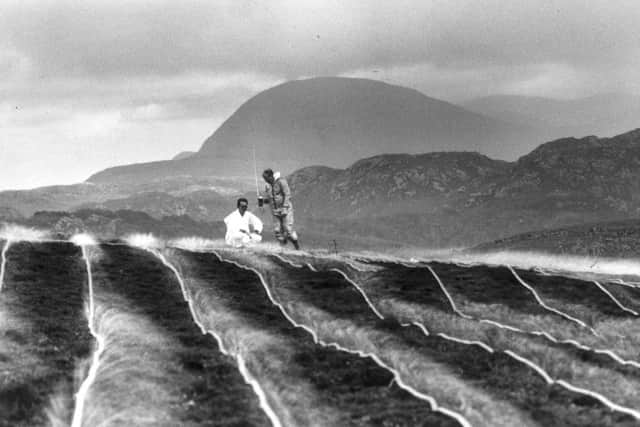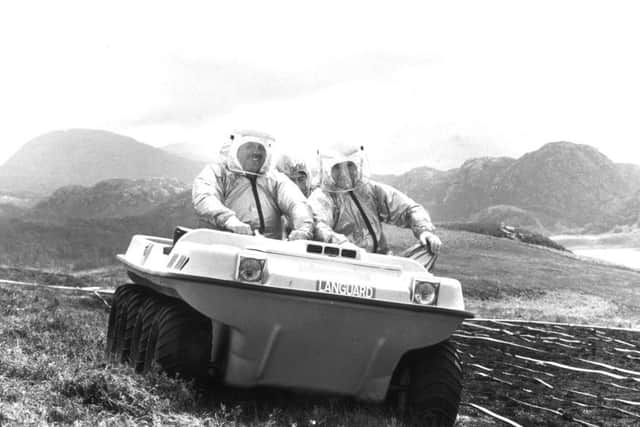The Scottish ‘Anthrax Island’ poisoned by the government


Even today, there are seldom any visitors to the isle apart from perhaps the odd curious kayaker lapping at its shores or a fisherman collecting a stranded buoy.
Gruinard has effectively been a no go zone for almost 80 years after it became a top-secret UK government test centre for biological weapons during World War Two.


Advertisement
Hide AdAdvertisement
Hide AdIt was here that anthrax bombs were dropped on sheep to determine how harmful the highly infectious disease could be in a warfare situation.
In 1942, British military scientists from Porton Down ventured to Gruinard which sits off the mainland between Achiltibuie and Laide in Wester Ross.
The sparse island, which is just over a mile long and once covered in trees, was then requisitioned from its owners to allow the covert tests to begin.


A team of 50 scientists were involved in the work with locals recalling the island becoming a hive of activity in the normally sedate landscape.
Over the summer of 1942 and 1943, sheep were placed in open pens and then exposed to bombs, dropped from a Vickers Wellington bomber plane, that scattered anthrax spores across the land.
The power of anthrax became quickly clear when the sheep started dying after three days with its potential to cause mass destruction summed up in the report of the tests.
“The report of the Gruinard experiment indicated that biological weapons are highly effective and can paralyse or render cities inhospitable,” said author Sharad S Chauhan in his book Biological Weapons.


There was concern about the welfare of those involved given the arrangements for “bio-safety were minimal”, Chauhan said.
Advertisement
Hide AdAdvertisement
Hide Ad“That led to surprise as how there were little or no casualties on the humans conducting the experiment,” he added.
With World War Two coming to an end, the Gruinard tests were abandoned with the owner requesting the island be returned to them.
With the island now heavily contaminated, it was agreed it would be sold back to the owner for £500 once the land was free from the disease.
Signs were placed around the shore warning of the no-go zone - but virtually no work was done on cleaning up the test site.
The legacy of the tests remained firm, however, when a sheep infected with the Gruinard anthrax washed up on the mainland.
Locals say that a dog was spotted eating the carcase, with the dog then becoming violently ill. From then, several farm and domestic animals died with farmers rapidly paid compensation by the authorities.
Those living in the area were then still largely unaware of the nature of the government’s work on Gruinard.
One told the BBC in a 1962 that the government paid up “without any quibble.”
Advertisement
Hide AdAdvertisement
Hide Ad“They knew there was something going on or they wouldn’t have paid up quite as quick as they did,” one farmer, who lost a horse and six sheep, said.
For 20 years, inspections of animals exposed to Gruinard revealed the continuing virulence of the spores left behind.
Sampling was most discontinued until 1979 when responsibility for Gruinard was given to the Chemical Defences Establishment at Porton Down.
It found that spores could be found in just three acres of the island - or one per cent of its total land mass.
Decontamination was plausible - but progress was slow.
On 1981, however, an environmental protest put Gruinard back into the spotlight. A group calling themselves Dark Harvest placed a bucket of soil containing anthrax outside the CDE in protest of perceived government indifference to the island’s contamination.
A sealed packed of soil was also left in Blackpool where the Conservative Party were holding their party conference, although it did not contain anthrax.
In 1986, a method of sterilising the topsoil was devised in 1986 with the land washed with formaldehyde and sea water.
After the decontamination, sheep were ferried daily from the mainland to graze on the island for a year to ensure it was now safe.
Advertisement
Hide AdAdvertisement
Hide AdIn 1990, the government sought to bring Gruinard’s dark chapter to a close by sending junior defence minister Michael Neubert to pose for cameras removing the warning signs from the shore.
Shortly after, the island was repurchased by the heir of the original owner, reportedly a lawyer’s wife from Edinburgh, for the original sale price of £500.
Still today, however, Gruinard stands lonely and little unloved given the darkness of its past.
